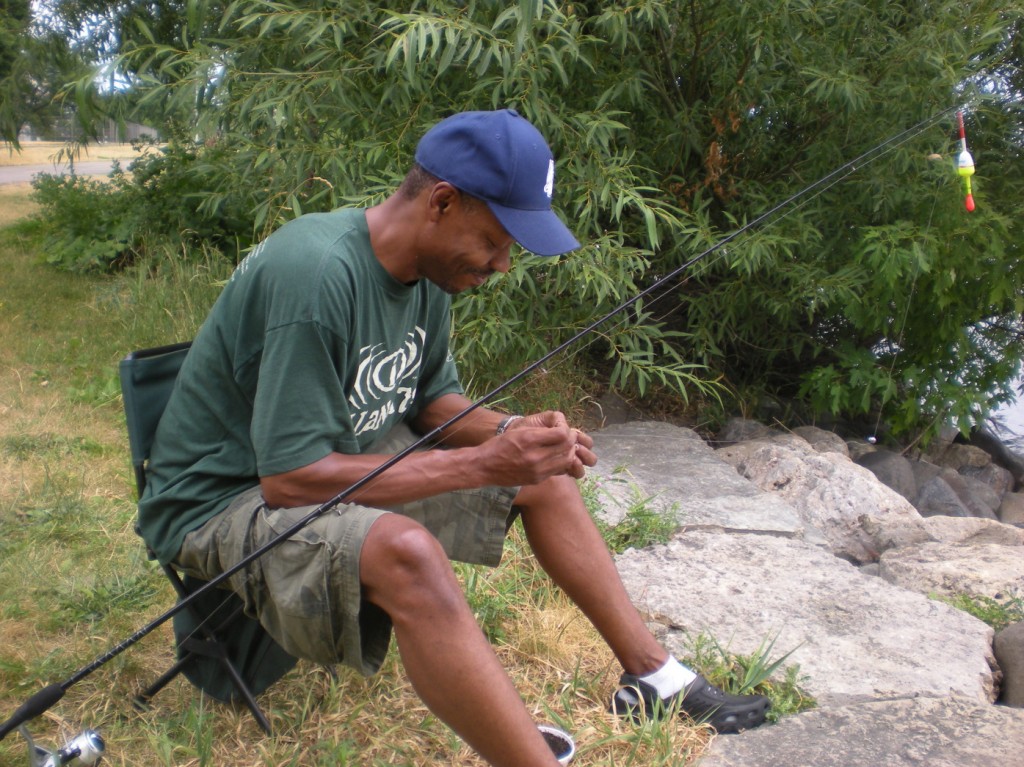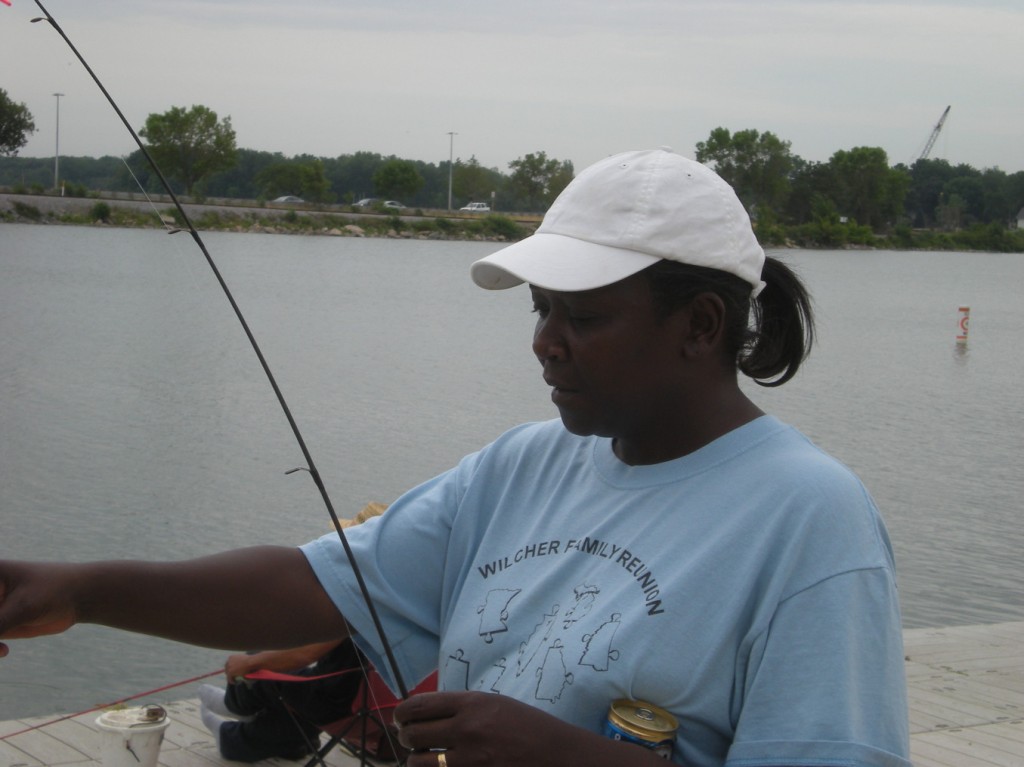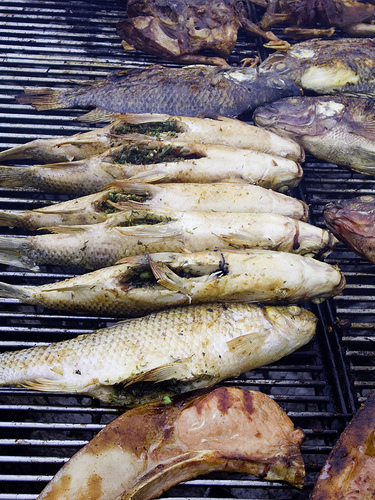By Rae Tyson, Environmental Health News

Trey Mackey baits his hook while trying to catch blue gill in Wisconsin’s Monona Bay. Photo: Rae Tyson.
Trey Mackey expertly baits his fishing hook with a live worm, sits down on a folding chair and casts a line into the waters of Monona Bay. He’s driven up from Chicago for a day of fishing that could provide a fresh, tasty dinner of blue gill.
But unbeknownst to Mackey, consuming some fish from the bay carries a significant health risk.
Every state, including Wisconsin, has issued health advisories for an array of rivers, lakes and bays that warn of the dangers of eating fish tainted with industrial compounds and other chemicals. For Mackey, who is African American, the risk is exacerbated: People of color eat a lot of locally-caught fish for economic and cultural reasons. And yet they are the least likely to be aware of the risks because state efforts to warn anglers fail to reach many minority and low-income populations.
Consumption of contaminated fish “is an especially pressing concern for many communities of color, low-income communities, tribes, and other indigenous peoples, whose members may consume fish, aquatic plants, and wildlife in greater quantities than does the general population,” according to a landmark Environmental Protection Agency study published nearly a decade ago.
Experts and activists call the government efforts to protect people of color from tainted fish woefully inadequate. In a 2012 Cornell University survey of more than 1,700 licensed anglers in the Great Lakes area, 61 percent of whites said they followed fish advisories, while only 50 percent of non-whites said they did.
“We believe that fish consumption is an environmental justice issue that stems from inadequate risk communication through fish consumption advisories,” wrote Michelle Martinez and Alexandria Teague of the University of Michigan’s School of Natural Resources and the Environment in a 2008 study.

Anglers fishing off a Great Lakes pier. Photo: Wisconsin Department of Natural Resources.
Many freshwater and ocean fish contain dangerous elements such as mercury, industrial chemicals such as dioxins and pesticides such as DDT that are linked to cancer, reproductive effects or other health problems.
Children, pregnant and nursing women and women of child-bearing age are most at risk. Scientific studies suggest that chemicals in fish can alter how the brain and reproductive system of a fetus or child develops, or raise the risk of diseases such as cancer later in life
Thirty-two states have issued statewide advisories warning anglers about specific fish and waterways, according to the EPA. And every state has issued a local advisory for at least one waterway.
Nationwide, 4,598 advisories encompassed 42 percent of all lake acreage and 36 percent of river miles in 2010. And the number is growing. A decade earlier, about 25 percent of lake acreage and less than 10 percent of river miles were under advisories. Eighty-three new ones were issued between 2008 and 2010, the EPA data show.
EPA officials said the increase in advisories is not indicative of an expanding problem. Instead, states have been testing a growing number of non-commercial fish. “The upward trend in advisories does not mean that contaminant levels in fish are increasing nationwide, rather states are monitoring more,” EPA officials said in a statement to Environmental Health News.
Because fish has high nutritional value and local waterways can offer an inexpensive source of protein, state agencies don’t want to discourage people from fishing in areas where contaminants are not considered risky. As a result, many states end up with a confusing patchwork of very specific advisories listing which species from which waterways are safe to eat.

The percentage of U.S. lake acres and river miles under fish advisories has been growing steadily. EPA officials say it’s due to increased state testing, not an increase in pollutants. Photo: U.S. EPA.
In general, most advisories warn children and pregnant women to avoid consuming fish from affected waterways. Some offer guidance on the frequency of consumption or size of the fish. Others, like some advisories for selected New York waterways, warn against eating any fish whatsoever.
In California alone, state officials list nearly 70 different advisories for lakes, rivers and bays. In San Francisco Bay, for example, special advisories are in place for American shad, Chinook salmon, steelhead trout, striped bass, white sturgeon and mussels.
Critics say that many of the advisories are so complex that, language barriers aside, they are difficult to understand.
“I have a Ph.D. and I don’t understand it,” said Maria Powell of the Midwest Environmental Justice Organization, an advocacy group.
Along Wisconsin’s Monona Bay one day this summer, a number of anglers — predominantly black — displayed a divergent understanding of the risks posed by chemicals in the fish, including mercury and industrial compounds called polychlorinated biphenyls (PCBs). Both are linked to neurological problems, and PCBs are carcinogens.
Mackey, a self-employed businessman, said he grew up in a family that fished regularly in the South because it was inexpensive and they liked the fresh food. He said he had never heard of a state advisory that recommends that people eat only one fish meal per week or month for most species caught in the bay. Women of child-bearing age and children are issued special advice. For six types of fish, including Mackey’s favorite blue gill, the state says men can eat unrestricted amounts. [Editor’s Note: Information about the advisory changed/added 9/18/2012]
Signs along the shore warning of the risks have been largely absent for several years, anglers said.
“I am not aware of any advisories,” said Mackey, who often shares his bounty with friends and family. “I just assumed it would be safe to eat.”
African Americans Gene and Janis Watson were both aware of the advisory but said they planned to eat the blue gill they caught. “I like to deep fry it,” Janis Watson said.
Along the polluted 18-Mile Creek in upstate New York, migrant farm worker Oscar Puente said he fishes to put food on his family’s table — even though a state advisory warns against consuming any fish there.
“I need to feed my family,” Puente said. Asked if he was aware of an advisory, Puente said, “The water is clean so the fish is okay.”
Powell said the lack of awareness is typical of many minority populations that fish in the Great Lakes region.
“It’s not surprising that a great many people have never seen those advisories,” she said. “This is a classic environmental justice issue.”

Janis Watson is aware of the fish advisories in Wisconsin’s Monona Bay, but said she eats the blue gill she catches anyway. Photo: Rae Tyson.
Many experts agree that cultural mores or economic necessity make it difficult to change attitudes about fish consumption.
“For some, fishing is a necessity and not a sport. If you need to put food on the table, or if your heritage is tied up with fishing, education can only go so far,” said Andria Ventura of California’s Clean Water Action.
Native Americans, such as the Mohawk in upstate New York and the Yakama and Nez Perce in the Columbia River basin, rely heavily on a diet of salmon, trout and other fish that are contaminated with PCBs, dioxins and other chemicals.
Immigrants from Southeast Asia also may be at higher risk because many are subsistence fishers, said Christina Medina of the Center for Environmental Health in Oakland, Calif. For example, fishing is an important aspect of the Hmong heritage.
“Fishing in a local lake is also an educational opportunity to passing on the fishing skills to their children or grandchildren while spending precious time together. Fishing also takes a lot of their stresses away. It reminds them of the past, how they used to fish in Laos,” said Kazoua Moua, a member of the Hmong community in Madison.
Language barriers and financial problems hamper efforts to warn anglers. For a nationwide advisory about mercury in fish, the EPA and Food and Drug Administration have translated their message into Spanish, Hmong, Chinese, Vietnamese, Portuguese, Cambodian and Korean. But some state agencies rely on brochures and signs in English, and website warnings may be ineffective for those who lack computer access.
Mixed messages from the states may be partially responsible for the significant percentage of anglers who are either unaware or choose to ignore state advisories.
In Western New York, the Niagara River is located near some of the nation’s most notorious chemical dumps, including Occidental Chemical’s Love Canal and Hyde Park. As a consequence, some of the earliest — and strictest — advisories have been in place for decades there for carcinogenic dioxins and other contaminants.

Fish is an important part of diet and culture for Hmong communities, who may not receive fish advisories because of language barriers or computer access. Photo: j l t/flickr.
But, while the New York departments of Health and Environmental Conservation have tried to publicize the risk, other state agencies have promoted sport fishing and have even constructed fish cleaning stations along the tainted Niagara River, where strict consumption advisories are in place. The advisory warns against eating any channel catfish, carp, lake trout over 25 inches, brown trout over 20 inches and white perch. For all other species, the recommendation is one fish meal per month — none for children or women under 50.
“That conflict undermines the importance of the issue,” said Katy Brown of Buffalo Niagara Riverkeeper, an advocacy group that disseminates information to minority anglers.
In Wisconsin, the state tourism office promotes sport fishing — with scant mention of any possible health risk. “Their position seems to be, the lakes and rivers are for recreation, not a source of food,” Powell said.
On the other hand, the Wisconsin Department of Natural Resources has tried a number of methods — including translation of brochures and websites into Spanish and Hmong — to try to spread the message.
Candy Schrank, a state toxicologist, defends the apparent conflict. “Tourism’s main mission is to connect visitors to activities and opportunities like fishing,” she said. “Most states have some level of fish consumption advice and most states have a wide variety and number of lakes and rivers that provide good opportunities for people to eat fish safely.”
Despite those efforts, a survey showed that only 42 percent of Wisconsin adults were aware of the fish advisories.
Some advisories may not provide adequate protection because they are based on state data that underestimate quantities consumed by minority, low-income populations. They also assume that anglers will clean and filet the fish when some eat the whole thing.
“There has been little emphasis on really understanding fish consumption practices among these populations,” Ventura said.
In Wisconsin, Mackey remained unconvinced that eating fish caught anywhere on the Great Lakes might pose a health threat.
“I’ll take anything that comes out of the water,” he said.
This story first appeared in Environmental Health News as part of its Pollution, Poverty, People of Color series.
Here in Michigan City, citizens started educating residents about the hazards of eating contaminated fish in the 1980s, over objections from the sport fishing community, local chambers of commerce and the media. It is a slow process and more environmental groups should continue to work on this important issue. Clean up our waterways and Great Lakes with GLRI money and don’t waste it doing more and more paper-shuffling studies!
Yes, we are slowly but surely poisoning our environment and therefore ourselves. If you don’t eat contaminated fish, you are eating other contaminated foods, breathing in these toxins or getting them in your drinking water. Rates of cancer, endocrine diseases, and neurological diseases are increasing in younger age groups. That is one helluva big can we are kicking down the road.
Most people I know of any color other than cutting the fat out of salmon eat everything they catch, when they catch no restrictions. Can’t see it must be OK. I quit eating salmon in the 70’s after they told us about PCB. The catch rate is low in West Michigan so they don’t eat that much.